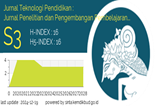Differences In Learning Outcomes Of Students Taught With Problem Based Learning Model Assisted By iSpring Suite 10 Media And Powerpoint On Chemical Equilibrium Material
Abstract
Keywords
Full Text:
PDFReferences
Aritonang, H. W., & Zubir, M. (2020). Perbedaan hasil belajar dan motivasi belajar siswa dengan menggunakan model PBL dan pembelajaran konvensional berbantuan media iSpring pada materi laju reaksi. Educater: Jurnal Ilmiah Pendidikan, 1(4), 346-352.
Ariyanti, D., Harwanto, & Mustaji. (2020). Multimedia Interaktif Berbasis iSpring Suite 8. Jurnal Education and Development, 8(2), 381–389.
Atika, D., Nuswowati, M., & Nurhayati, S. (2018). Pengaruh metode discovery learning berbantuan video terhadap hasil belajar kimia siswa SMA. Jurnal Inovasi Pendidikan Kimia,12(2).
Budiariawan, I. P. (2019). Hubungan motivasi belajar dengan hasil belajar pada mata pelajaran kimia. Jurnal Pendidikan Kimia Indonesia, 3(2), 103-111.
Dalimunthe, S. K., & Roza, D. (2021). Pengembangan Media Pembelajaran Berbasis Ispring Presenter Untuk Meningkatkan Hasil Belajar Siswa Pada Materi MInyak Bumi. Prosiding Seminar Nasional Kimia, 159-165.
Darmadi, H. (2019). Pengantar Pendidikan Era Globalisasi: Konsep Dasar, Teori, Strategi, dan Implementasi Dalam Pendidikan Globalisasi. Banten: An1mage.
Dasmo, D., Lestari, A. P., & Alamsyah, M. (2020). Peningkatan hasil belajar fisika melalui penerapan media pembelajaran interaktif berbasis iSpring Suite 9. In SINASIS (Seminar Nasional Sains), 1(01).
Faizah, S. N. (2017). Hakikat Belajar dan Pembelajaran. At-Thullab: Jurnal Pendidikan Guru Madrasah Ibtidaiyah, 175-185.
Indriani, A. S. (2017). Identifikasi kesulitan peserta didik dalam memahami kesetimbangan kimia. J-PEK (Jurnal Pembelajaran Kimia), 2(1), 9-13.
Jannah, M. C. (2018). Pengaruh Model Problem Based Learning Terhadap Hasil Belajar Dan Keterampilan Proses Sains. Jurnal Inovasi Pendidikan Kimia, 2097 – 2107.
Maulana, M. P., Solikhin, F., & Dewi, K. (2021). Penerapan Model Problem Based Learning (PBL) Dalam Meningkatkan Aktivitas Dan Hasil Belajar Peserta Didik Pada Materi Kesetimbangan Kimia SMAN 3 Kota Bengkulu. Jurnal Zarah, 9(2), 75-82.
Mawarni, R., & Syafriani, D. (2022). Pengaruh Model Pembelajaran dan Minat Belajar Terhadap Hasil Belajar Siswa Pada Materi Kesetimbangan Kimia Di SMA. Jurnal Sekolah, 139-145.
Sastrakusumah, E. N., Suherman, U., Darmawan, D., & Jamilah, J. (2018). Pengaruh media pembelajaran interaktif berbantuan aplikasi iSpring presenter terhadap kemampuan berpikir kritis. Teknologi Pembelajaran, 3(1).
Sufairoh. (2017). Pendekatan saintifik dan model pembelajaran K-13. Jurnal Pendidikan Profesional, 122-123.
Valdez, J. E., & Bungihan, M. E. (2019). Problem-based learning approach enhances the problem solving skills in chemistry of high school students. Journal of Technology and Science Education, 9(3), 282–294. https://doi.org/10.3926/JOTSE.631.
Watoni, M., & Savalas, L. R. (2021). Pengaruh Model Pembelajaran Berbasis Masalah Terhadap Hasil Belajar Siswa Kelas XI IPA SMAN 4 Praya Pada Materi Laju Reaksi Tahun Pelajaran 2019/2020. Jurnal Ilmiah Pendidikan Indonesia, 3(1), 71-76.
DOI: https://doi.org/10.33394/jtp.v8i3.7439
Refbacks
- There are currently no refbacks.
Copyright (c) 2023 Ayulia Annisa Nasution, Jasmidi Jasmidi Jasmidi

This work is licensed under a Creative Commons Attribution-ShareAlike 4.0 International License.
This Journal has been Indexed by:
Jurnal Teknologi Pendidikan
ISSN: 2656-1417 (Online)
ISSN: 2503-0620 (Print)
Published by Program Studi Teknologi Pendidikan, FIPP
Universitas Pendidikan Mandalika
Email: [email protected]

This work is licensed under a Creative Commons Attribution-ShareAlike 4.0 International License.















.png)






